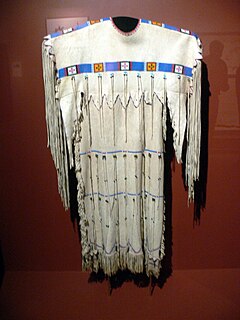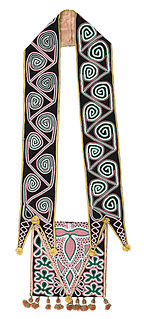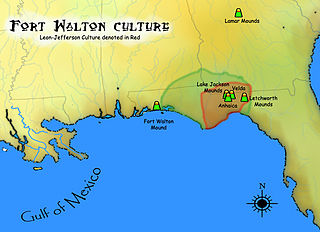Sam Story, also named Timpoochee Kinnard, was Chief of the Walton County, Florida, band of Euchee (Yuchi) Indians in the early 19th century, who occupied the lands on and to the west of the Choctawhatchee River. His parents were Timothy Kinnard, a white man of Scottish descent, and an unknown Yuchi woman. The chief was a well-known figure in the Florida Panhandle and was highly respected by whites, who migrated to the area in ever-increasing numbers following the acquisition of Florida by the United States from Spain in 1821.

Walton County is located in the state of Florida, with its southern border on the Gulf of Mexico. As of the 2010 census, the population was 55,043. Its county seat is DeFuniak Springs. The county is home to the highest natural point in Florida: Britton Hill, at 345 feet (105 m).

The Yuchi people, spelled Euchee and Uchee, are people of a Native American tribe who historically lived in the eastern Tennessee River valley in Tennessee in the 16th century. The Yuchi built monumental earthworks. In the late 17th century, they moved south to Alabama, Georgia, and South Carolina. Some also migrated to the panhandle of Florida. After suffering many fatalities from epidemic disease and warfare in the 18th century, several surviving Yuchi were removed to Indian Territory in the 1830s, together with their allies the Muscogee Creek.

The Choctawhatchee River is a 141-mile-long (227 km) river in the southern United States, flowing through southeast Alabama and the Panhandle of Florida before emptying into Choctawhatchee Bay in Okaloosa and Walton counties. The river, the bay and their adjacent watersheds collectively drain 5,350 square miles (13,900 km2).
In the spring of 1820, Neil McLennan and brother-in-law Daniel Campbell moved their families from Richmond County, North Carolina, to Walton County, Florida, where they were invited by Chief Sam Story to settle on lands adjoining his on Bruce Creek in the Euchee Valley. These Scots first camped near Pensacola and met the Chief in town when he was there trading for supplies. After becoming the first white settlers in Walton County, they were soon joined by other relatives and friends, drawn by the fertility of the soil and the unspoiled wilderness.
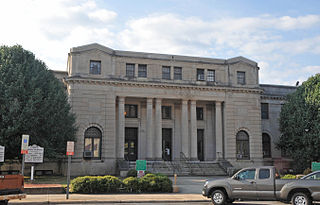
Richmond County is a county located in the U.S. state of North Carolina. As of the 2010 Census, the population was 46,639. Its county seat is Rockingham.
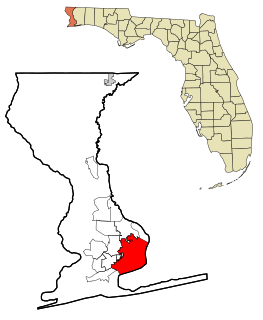
Pensacola is the westernmost city in the Florida Panhandle, approximately 13 miles (21 km) from the border with Alabama, and the county seat of Escambia County, in the U.S. state of Florida. As of the 2010 census, the city had a total population of 51,923, down from 56,255 at the 2000 census. Pensacola is the principal city of the Pensacola metropolitan area, which had an estimated 461,227 residents in 2012.
However, by 1832, other white people had moved into the area and were wantonly destroying the wildlife as well as starting forest fires. Both the McLennans and old Chief Story decided to depart for better places; the Chief sent his sons to scout for lands to the east, while many of the McLennans and their kin decided to head west by boat, and became prominent early settlers of what later was named McLennan County, Texas.
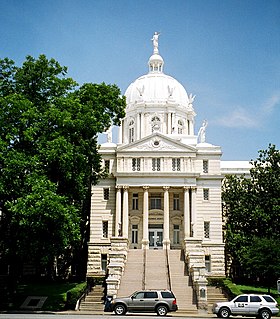
McLennan County is a county located on the Edwards Plateau in Central Texas. As of the 2010 census, its population was 234,906. Its county seat is Waco. The U.S. census 2017 county population estimate is 251,259. The county is named for Neil McLennan, an early settler.
Chief Sam Story died just before his tribe moved, and is buried south of the fork of Bruce Creek and the Choctawhatchee River. After three weeks of mourning, about 500 Euchees went southward to the coast of the Gulf of Mexico, embarking on their canoes at Story's Landing, near the burial site of the chief, southeast of the modern community of Red Bay in Walton County. Story's Landing is marked by a man-made marker in the Choctawhatchee River at N30° 35.979, W83° 54.911. They then traveled eastward, both by land and by water. Nothing further was heard of them. Some may have eventually settled with the Seminole Indians in South Florida. It is definitely known, however, that the United States Army forced some of the Walton County Euchees and several other small West Florida bands to relocate west of the Mississippi River.

The United States Army (USA) is the land warfare service branch of the United States Armed Forces. It is one of the seven uniformed services of the United States, and is designated as the Army of the United States in the United States Constitution. As the oldest and most senior branch of the U.S. military in order of precedence, the modern U.S. Army has its roots in the Continental Army, which was formed to fight the American Revolutionary War (1775–1783)—before the United States of America was established as a country. After the Revolutionary War, the Congress of the Confederation created the United States Army on 3 June 1784 to replace the disbanded Continental Army. The United States Army considers itself descended from the Continental Army, and dates its institutional inception from the origin of that armed force in 1775.

West Florida was a region on the north shore of the Gulf of Mexico that underwent several boundary and sovereignty changes during its history. As its name suggests, it was formed out of the western part of former Spanish Florida, along with lands taken from French Louisiana; West Florida's capital was Pensacola. The colony included about 2/3 of what is now the Florida Panhandle, as well as parts of the modern U.S. states of Louisiana, Mississippi, and Alabama.
Chief Sam Story had three sons, Jim Crow, Swift Hunter and Sleeping Fire, and three daughters, Leaping Water, Quiet Water and Round Water. Jim Crow, and perhaps others of the tribe, left numerous descendants, some of them called Dominickers, in Walton, Holmes, and Washington counties.
The Dominickers are a small biracial or triracial ethnic group that was once centered in the Florida Panhandle county of Holmes, in a corner of the southern part of the county west of the Choctawhatchee River, near the town of Ponce de Leon. The group was classified in 1950 as one of the "reputed Indian-White-Negro racial isolates of the Eastern United States" by the United States Census Bureau.

Holmes County is a county located in the U.S. state of Florida. As of the 2010 census, the population was 19,927. Its county seat is Bonifay.

Washington County is a county located in the state of Florida. As of the 2010 census, the population was 24,935. Its county seat is Chipley. Washington County is a prohibition or entirely dry county, meaning that the sale of alcoholic beverages is banned in the county.

